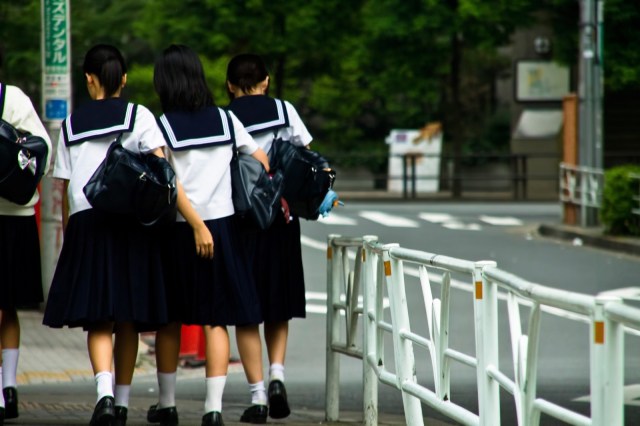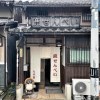
Law association calls practice a violation of human rights.
Almost all schools in Japan require their students to wear uniforms, and often even have rules about what kind of bags and hair ties are acceptable. But perhaps the strangest point of dress codes in Japan can be found at schools which officially state that students must wear plain white underwear.
While not every school has such a requirement, it’s common enough that a recent Saga Prefectural Bar Association study of 22 public middle schools in Saga City found that a majority of them, 13, have such rules in place for their students. The ostensible rationale is that the children’s undergarments should be simple and chaste so as not to cause distractions or contribute to a sexualized atmosphere, and white underwear, particularly white bras, are the least likely color to show a visible outline from under the students’ uniforms.
In and of themselves, the goals are understandable, and while it’s kind of weird to phrase the rule as “white underwear only” instead of “visible underwear colors not allowed,” in practice as long as the non-white underwear isn’t visible, no one will know it’s not white, and the students won’t get in trouble for it, right? Not necessarily. The bar association’s study found that at least one school with the rule, if not more, periodically checks what color of bra female students are wearing that day.
The students (who would be between the ages of 12 and 15) aren’t required to take off their tops for the inspections, but instead a teacher pulls one of the girls’ bra straps up through the collar of her blouse to check its color. The check is performed, at least, by a female teacher, but the bar association still finds the practice reprehensible, saying:
“Commanding someone to show their underwear is a violation of a person’s human rights. It is not acceptable simply because it is a child who is being given the command.”
The statement was part of a report submitted by the bar association to the Saga Prefectural Board of Education and local PTA organizations calling for a reform of school rules. Other questionable regulations discussed in the report include bans on “soft mohawk” hairstyles, not allowing students to wear mufflers when in uniform, and different dress code/hair style rules depending on the student’s gender. Also discussed is the potential confusion from schools having both rules restricting social media use, in the interest of protecting students’ privacy, yet requiring visible name tags on their uniforms, thus revealing their names to passersby on their way to/from campus.
The bar association urges schools to reconsider whether their rules actually have a positive effect on the quality of the students’ education, particularly in the modern era, and to take student input into consideration when making revisions in order to help cultivate a feeling of mutual understanding.
Sources: Yomiuri Shimbun via Livedoor News via Jin, Saga Shimbun Live via Hachima Kiko
Top image: Pakutaso
● Want to hear about SoraNews24’s latest articles as soon as they’re published? Follow us on Facebook and Twitter!

 Line up in the hall, open your shirts, show your bras – Real instructions from one Japanese school
Line up in the hall, open your shirts, show your bras – Real instructions from one Japanese school Public schools in Japan’s Saga Prefecture will no longer regulate/check students’ underwear color
Public schools in Japan’s Saga Prefecture will no longer regulate/check students’ underwear color Majority of Nagasaki high schools and middle schools have white-underwear-only rules, study finds
Majority of Nagasaki high schools and middle schools have white-underwear-only rules, study finds Tokyo junior high school demands students wear white underwear as part of dress code
Tokyo junior high school demands students wear white underwear as part of dress code Petition to allow students to choose what they wear to school gathers almost 19,000 signatures
Petition to allow students to choose what they wear to school gathers almost 19,000 signatures How to order snacks on a Shinkansen bullet train in Japan
How to order snacks on a Shinkansen bullet train in Japan Japan’s new difficult-to-drink-from beer glass protects your liver, but it’s a brutal experience
Japan’s new difficult-to-drink-from beer glass protects your liver, but it’s a brutal experience Burger King Japan suddenly adds Dr. Pepper and Dr. Pepper floats to its menu nationwide
Burger King Japan suddenly adds Dr. Pepper and Dr. Pepper floats to its menu nationwide Demon Slayer: Kimetsu no Yaiba gets new roller coaster attractions and food at Universal Studios Japan
Demon Slayer: Kimetsu no Yaiba gets new roller coaster attractions and food at Universal Studios Japan Hello, cosmetics! Clinique teams up with Hello Kitty this summer for first-time collaboration
Hello, cosmetics! Clinique teams up with Hello Kitty this summer for first-time collaboration Kyoto Tower mascot termination reveals dark side behind cute Japanese characters
Kyoto Tower mascot termination reveals dark side behind cute Japanese characters Nintendo history you can feel – Super NES, N64, and GameCube controllers become capsule toys
Nintendo history you can feel – Super NES, N64, and GameCube controllers become capsule toys This Nara workshop has been making deer crackers for more than 100 years and offers tours【Photos】
This Nara workshop has been making deer crackers for more than 100 years and offers tours【Photos】 High-fashion Totoro cuddle purse is like an elegant stroll in the forest【Photos】
High-fashion Totoro cuddle purse is like an elegant stroll in the forest【Photos】 Legendary Melon Bread by Tokyo Banana returns after 20-year absence【Taste Test】
Legendary Melon Bread by Tokyo Banana returns after 20-year absence【Taste Test】 “The most Delicious Cup Noodle in history” – Japan’s French Cup Noodle wins our heart【Taste test】
“The most Delicious Cup Noodle in history” – Japan’s French Cup Noodle wins our heart【Taste test】 Starbucks releases a cute Frappuccino and Unicorn Cake…but not in Japan
Starbucks releases a cute Frappuccino and Unicorn Cake…but not in Japan McDonald’s Japan’s Soft Twist Tower: A phantom ice cream only sold at select branches
McDonald’s Japan’s Soft Twist Tower: A phantom ice cream only sold at select branches Yabai Ramen: What makes this Japanese ramen so dangerous?
Yabai Ramen: What makes this Japanese ramen so dangerous? Finally! Nintendo Japan expands Switch 8-bit controller sales to everybody, Online member or not
Finally! Nintendo Japan expands Switch 8-bit controller sales to everybody, Online member or not Japanese government wants to build luxury resorts in all national parks for foreign tourists
Japanese government wants to build luxury resorts in all national parks for foreign tourists To combat declining birth rate, Japan to begin offering “Breeding Visas” to foreigners
To combat declining birth rate, Japan to begin offering “Breeding Visas” to foreigners 10 things you should buy at 7-Eleven in Japan
10 things you should buy at 7-Eleven in Japan Studio Ghibli releases anime heroine cosplay dresses that are super comfy to wear
Studio Ghibli releases anime heroine cosplay dresses that are super comfy to wear Woman charged for driving suitcase without a license in Osaka
Woman charged for driving suitcase without a license in Osaka Studio Ghibli unveils My Neighbour Totoro miniature house model
Studio Ghibli unveils My Neighbour Totoro miniature house model Kyoto experiencing problems with foreign tourists not paying for bus fares, but not on purpose
Kyoto experiencing problems with foreign tourists not paying for bus fares, but not on purpose Fighting mild hunger with a Japanese soda that turns into jelly in the stomach【Taste test】
Fighting mild hunger with a Japanese soda that turns into jelly in the stomach【Taste test】 Studio Ghibli’s Howl’s Moving Castle tapestry unveiled in Japan for first time
Studio Ghibli’s Howl’s Moving Castle tapestry unveiled in Japan for first time McDonald’s new Happy Meals offer up cute and practical Sanrio lifestyle goods
McDonald’s new Happy Meals offer up cute and practical Sanrio lifestyle goods Sales of Japan’s most convenient train ticket/shopping payment cards suspended indefinitely
Sales of Japan’s most convenient train ticket/shopping payment cards suspended indefinitely Sold-out Studio Ghibli desktop humidifiers are back so Totoro can help you through the dry season
Sold-out Studio Ghibli desktop humidifiers are back so Totoro can help you through the dry season Japanese government to make first change to romanization spelling rules since the 1950s
Japanese government to make first change to romanization spelling rules since the 1950s Foreigner’s request for help in Tokyo makes us sad for the state of society
Foreigner’s request for help in Tokyo makes us sad for the state of society Ghibli founders Toshio Suzuki and Hayao Miyazaki contribute to Japanese whisky Totoro label design
Ghibli founders Toshio Suzuki and Hayao Miyazaki contribute to Japanese whisky Totoro label design Doraemon found buried at sea as scene from 1993 anime becomes real life【Photos】
Doraemon found buried at sea as scene from 1993 anime becomes real life【Photos】 Tokyo’s most famous Starbucks is closed
Tokyo’s most famous Starbucks is closed Princesses, fruits, and blacksmiths: Study reveals the 30 most unusual family names in Japan
Princesses, fruits, and blacksmiths: Study reveals the 30 most unusual family names in Japan Dumb Japanese school dress codes — Coronavirus winter edition
Dumb Japanese school dress codes — Coronavirus winter edition Tokyo public schools will stop forcing students with non-black hair to dye it, official promises
Tokyo public schools will stop forcing students with non-black hair to dye it, official promises Japanese junior high school girl removed for class from three days for grooming her eyebrows
Japanese junior high school girl removed for class from three days for grooming her eyebrows Japanese schoolgirl points out an especially dumb part of her school’s “no tights” dress code
Japanese schoolgirl points out an especially dumb part of her school’s “no tights” dress code Japanese public school to allow male students to wear skirts, chest ribbons as part of uniform
Japanese public school to allow male students to wear skirts, chest ribbons as part of uniform “Students are only allowed three sneezes in class” Japanese people share their worst school rules
“Students are only allowed three sneezes in class” Japanese people share their worst school rules Japanese McDonalds’ branch bans an entire middle school from entering the restaurant
Japanese McDonalds’ branch bans an entire middle school from entering the restaurant Snappy as they look, Japanese school uniforms can be an extremely expensive hassle for parents
Snappy as they look, Japanese school uniforms can be an extremely expensive hassle for parents Japanese high schools stop asking students to specify their gender on application forms
Japanese high schools stop asking students to specify their gender on application forms Japanese high school requires teens to kneel and bow for teaches, receives harsh online backlash
Japanese high school requires teens to kneel and bow for teaches, receives harsh online backlash Study reveals too much Internet and video games is bad for your grades
Study reveals too much Internet and video games is bad for your grades Manga artist wants Japanese teachers to feel, for two seconds, how dumb their girls’ dress code is
Manga artist wants Japanese teachers to feel, for two seconds, how dumb their girls’ dress code is American English teacher fired from Japanese high school after exposing genitals
American English teacher fired from Japanese high school after exposing genitals Teacher says Japanese schools’ mandatory extracurricular activity rules don’t benefit students
Teacher says Japanese schools’ mandatory extracurricular activity rules don’t benefit students Impractical yet adorable Hello Kitty school uniform set for spring debut
Impractical yet adorable Hello Kitty school uniform set for spring debut
Leave a Reply